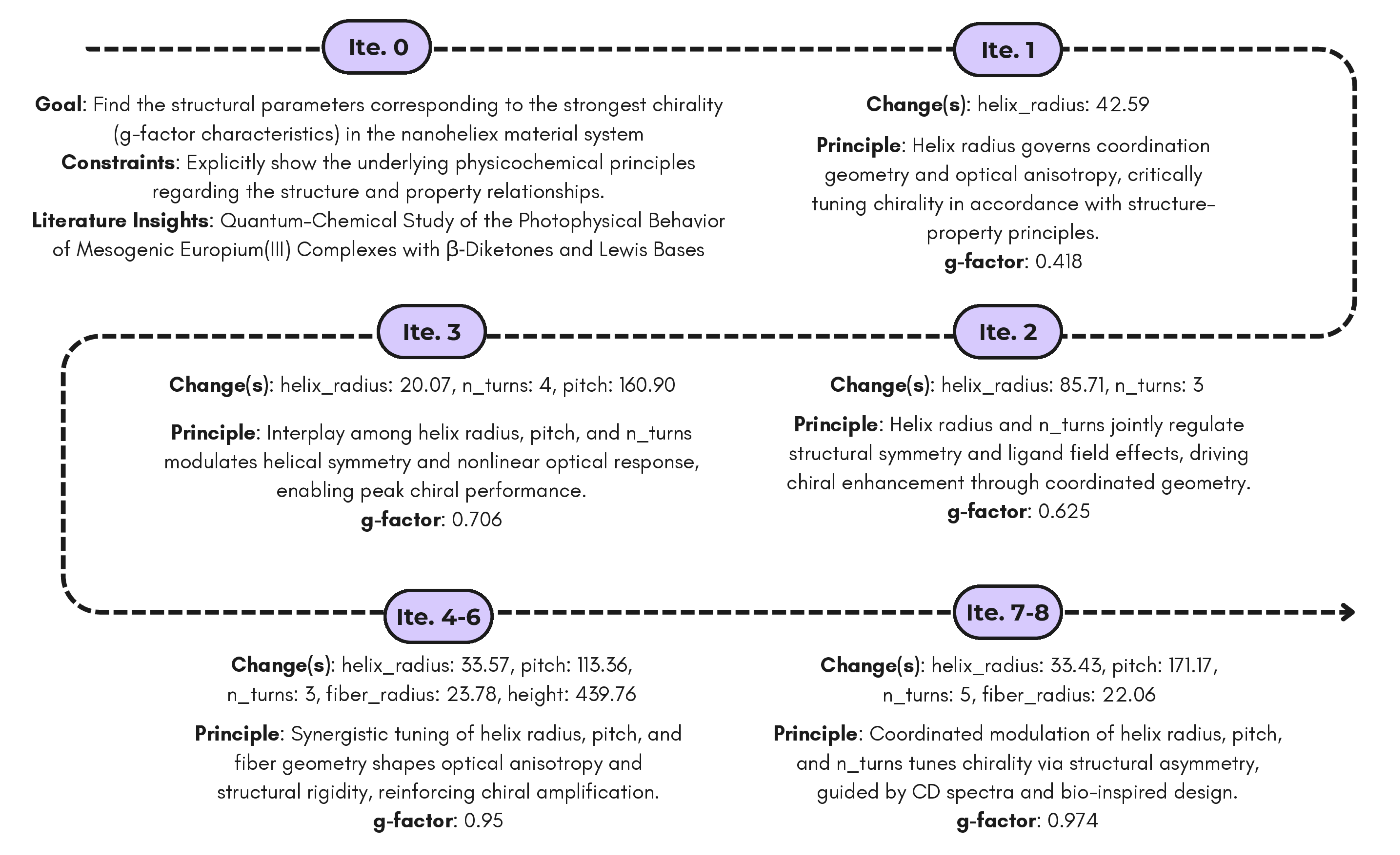PriM
We introduce a hypothesis-validation framework with language model-based multi-agent system for scientific discovery.
PriM: Principle-Inspired Material Discovery through Multi-Agent Collaboration
2 Westlake University
3 Zhejiang University

Complex chemical space and limited knowledge scope with biases holds immense challenge for human scientists, yet in automated materials discovery. Existing intelligent methods relies more on numerical computation, leading to inefficient exploration and results with hard-interpretability. To bridge this gap, we introduce a principles-guided materials discovery workflow powered by language inferential multi-agent system (MAS). Our framework integrates automated hypothesis generation with experimental validation in a roundtable system of MAS, enabling systematic exploration while maintaining scientific rigor. Based on our framework, the case study of nano helix demonstrates higher materials exploration rate and property value while providing transparent reasoning pathways. This approach develops an automated-and-transparent paradigm for material discovery, with broad implications for rational design of functional materials.
Framework Overview
The PriM framework bridges the gap between traditional data-driven methods and principled scientific reasoning. It achieves this by combining:
- Hypothesis Generation: A Literature Agent retrieves relevant scientific knowledge, and a Hypothesis Agent formulates testable propositions based on physicochemical principles.
- Experimental Validation: An Experiment Agent designs and executes virtual experiments, while an Optimizer Agent refines the parameter space via Monte Carlo Tree Search (MCTS) to maximize the desired material property.
- Transparent Reasoning: All decision-making is traceable through explicit, human-readable reasoning paths, facilitating deeper insights into material behavior.
Results and Comparative Analysis
We evaluated the performance of PriM against several baseline methods including Bayesian Optimization (BO), Deep Q-Networks (DQN), and traditional multi-agent systems. The quantitative results are presented in Table 1.
| Method | Rationality | Optimal Value (μ) | Exploration Rate (ε) | Iteration |
|---|---|---|---|---|
| BO | N/A | 1.081 (± 0.065) | 467.35 (± 23.52) | 14.29 (± 2.34) |
| DQN | N/A | 1.050 (± 0.021) | 6.75 (± 0.30) | 20.00 (± 0.00) |
| Vanilla Agent | Naive Logics | 0.644 (± 0.054) | 24.47 (± 7.34) | 9.20 (± 2.56) |
| Vanilla MAS | Naive Logics | 0.923 (± 0.170) | 264.65 (± 22.42) | 65.40 (± 18.91) |
| PriM (Ours) | Principles | 1.007 (± 0.103) | 49.68 (± 10.07) | 85.50 (± 8.58) |
n = 5 independent runs for each method; all values reported as mean ± standard deviation.
◊ Key Finding: PriM achieves near-optimal material properties (μ = 1.007 ± 0.103) while maintaining scientific rationality through principle-guided approaches. The significantly lower exploration rate (ε = 49.68 ± 10.07) compared to Vanilla MAS (ε = 264.65 ± 22.42) demonstrates more efficient and targeted parameter space traversal, effectively balancing performance optimization with mechanistic understanding.
Case Study: Nano Helix Material Discovery

PriM applied to nano helix material discovery, demonstrating iterative agent collaboration and significant property improvements.
The system is demonstrated on a nano helix material discovery case study, where iterative agent collaboration results in significant improvements in material properties compared to conventional methods. The transparent reasoning paths provide insights into the material behavior and guide further exploration.
Key Advantages
Combines scientific principles with data-driven optimization, enabling more efficient navigation of complex chemical space.
Provides human-readable reasoning paths, allowing scientists to understand and validate the material discovery process.
Multiple specialized agents work together to address different aspects of the discovery process, leading to more comprehensive solutions.